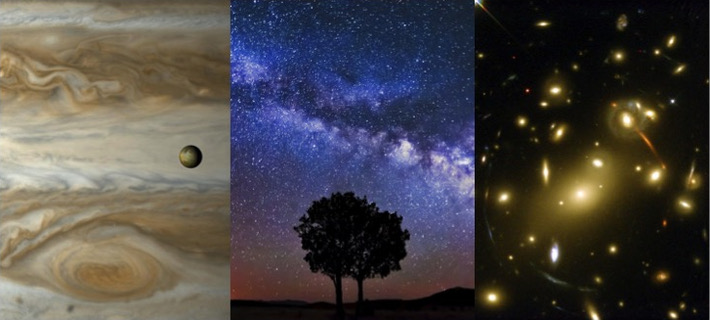Overview
Astronomy 1101 is an overview of astronomy, from our solar system to the universe as a whole. It is a General Education (GE) Physical Science course in the Natural Science category. The goals of courses in this category are for students to understand the principles, theories, and methods of modern science, the relationship between science and technology, the implications of scientific discoveries, and the potential of science and technology to address problems of the contemporary world. By the end of this course, students should successfully be able to:- Understand the basic facts, principles, theories, and methods of modern science.
- Understand key events in the development of science and recognize that science is an evolving body of knowledge.
- Describe the interdependence of scientific and technological developments.
- Recognize social and philosophical implications of scientific discoveries and understand the potential of science and technology to address problems of the contemporary world.
- The Long Copernican Revolution
- The nature of our solar system; planetary systems around other
stars; the physics of gravity.
- The Lives of Stars
- The nature and evolution of stars; the origin of the elements; the
physics of light.
- The Cosmos
- The nature and evolution of galaxies; evidence for the Big Bang; the structure of the universe on its largest scales.
- What is the architecture of our solar system, and how do we find other planetary systems?
- What is a star? How do stars form and evolve?
- What is a galaxy? How do galaxies form and evolve?
- What is the evidence for dark matter and dark energy?
- What is the Big Bang?
- What evidence supports or challenges our explanations for the physical nature of stars, galaxies, and the cosmos?
- What is a star? How do stars form and evolve?
Course Organization
Astronomy 1101 is a 4 credit hour course; each week, there will be 3 hours of lecture and one two-hour laboratory session. For Arts and Sciences students in a Bachelor of Arts program, this course meets the Arts and Sciences GE requirement of a natural sciences course that includes a laboratory component.Lecture
Lectures are Monday, Wednesday, and Friday at the regular class time. The lectures, along with the labs and homework assignments, are your primary source of course content. Exams are based on the lectures and the lab exercises; there is no assigned textbook for this course. As a courtesy to your fellow students, silence all electronic devices during lecture, and keep in mind that videos and animations on your laptop or tablet are distracting to those seated behind you.Labs
The lab portion of Astronomy 1101 meets once each week for 2 hours. Attendance is mandatory. The primary goal of the labs is to reinforce the concepts covered in lecture and to introduce quantitative thinking. All labs start with a half-hour session in the OSU Slettebak Planetarium (5033 Smith Laboratory) that introduces the topic for the day's lab. The class then divides into smaller groups who accompany their TA to their assigned rooms in Smith Lab for the lab work proper.Each student is expected to finish their in-class lab write-up before the end of the session; however, this write-up can be taken home to use with the homework assignment handed out at the end of each lab. The write-up and the homework will then be handed in at the start of the next lab session.
